The street is my sketchbook. This is where I practice my craft so I can get better at wedding photography. One of the best places (and my favourite) is Chinatown and Kensington Market here in Toronto, as there is always something going on. The vibe is raw, yet friendly. Yes, some people turn away, but most don’t mind. If you’re ever visiting this awesome city, I highly suggest checking it out.
All of these shots were done with the Fuji X-100. I LOVE THIS CAMERA!!! It forces you to work a little hard, but that’s a good thing. Personally I would rather have a 50mm lens, but that would mean I would be in my comfort zone. The 35mm equivalent really forces me to move really close to my subjects, which can sometimes be a little bit intimidating, but I’m getting used to it. As a matter of fact, I think my photography has really improved ever since I bought it. I firmly believe that if I keep shooting with a prime, I will keep getting better and better. Gonna definitely take it to the next wedding shoot.
One day I will own a Leica M9……or M12 by that time………or maybe even the X-200 with interchangeable lenses….haha (I’m praying!). Time will tell. In the end what really matters is the image.
So just keep shooting 🙂
Cheers,
Mike Swiegot
P.S. Thank you Steve for an awesome website! It’s a nice way to start off my day.

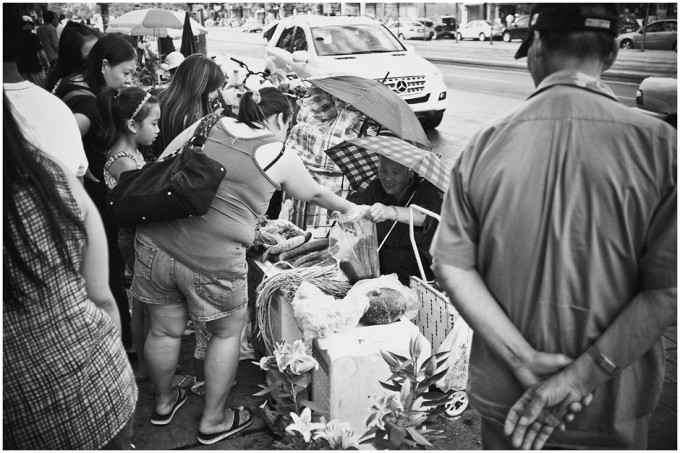
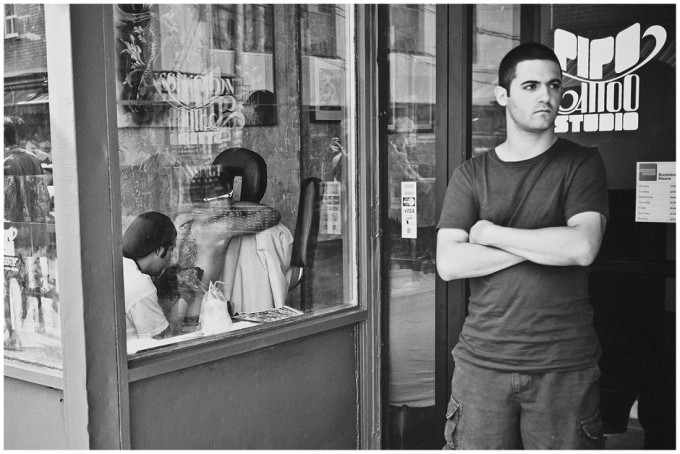
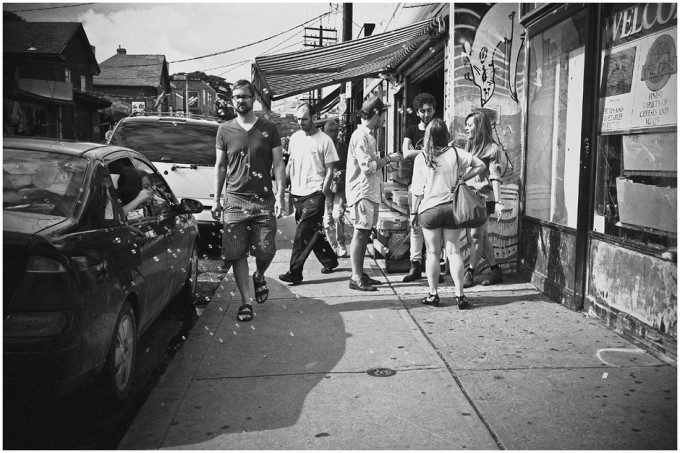
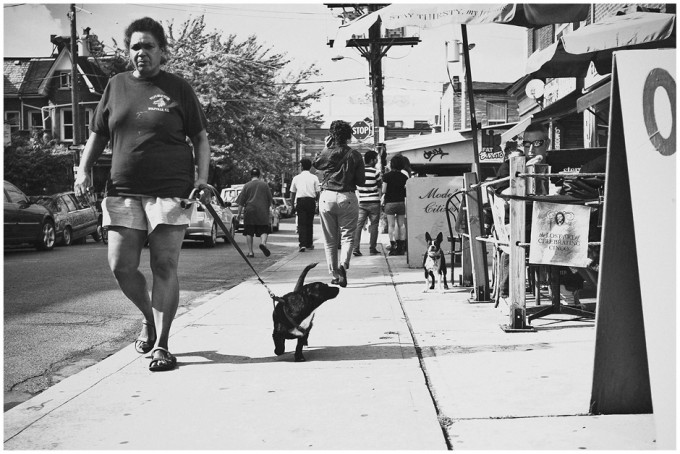
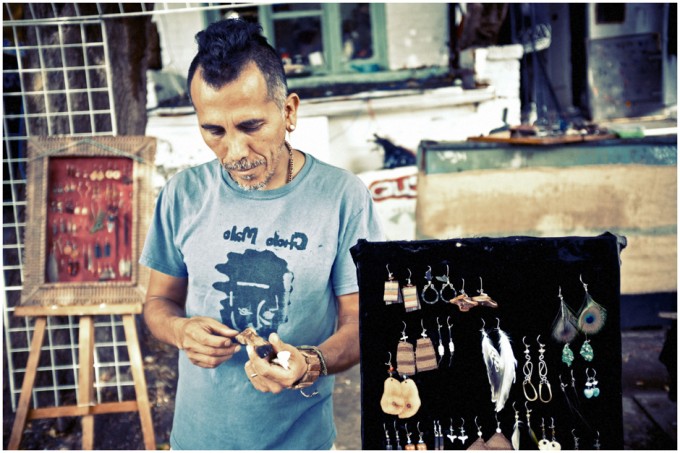


Wow. Thanks for the link.
You’re right, david, you just don’t understand. And many of us have tried to help you understand so, so many times already, so you can shelve the cry for help routine. We get it: you dont think street photography is valid; you don’t understand why some photographers don’t need more than one normal lens. You’ve made. Bloody spectacle out of you failures of understanding.
Enough already. If you refuse to understand others’ work on its own terms, at least try and refrain from going out of your way to denigrate it just for not being your particular cup of tea. It’s tedious.
Contacts- great series with great photographers (HCB, doisneau, klein, erwitt, salgado…) discussing a few of their sheets and what it takes to ‘make’ a good photograph:
http://www.youtube.com/watch?v=luGuHXgbHVs&feature=related
Street photography? Luck or skill? I only noticed the third part of the triangle (the little girl) after developing the film.
Nikon FM2n, 2.0/35 Ai-S, Tri-X, “grabbed shot”, 2011.
http://www.facebook.com/photo.php?fbid=2901685654120&set=o.187179964626124&type=3&theater
@David: I agree wholly (as well). I tried “street photography” too for a while, and decided I just wasn’t good enough (or persistent enough) at it to produce a relevant number of interesting images (I did manage a few I think where the composition presented a certain tension).
I also participated for a while in a Dutch FB street photography group. To most of the images posted there my first and only reaction was: “Yes, that’s a street and yes, there are people in it” (much as my reaction to these images is). I even posted a “photosociological” essay once in the group, commenting on images like these, produced by photographers subscribing to the “random scene configuration” school of photography. In other words, a total lack of compositional skills.
On the other hand. Why begrudge someone the pleasure of discovering photography by going out into the street with his modern rf replica and imagining he’s a great street photographer in the making?
Cheers,
Michiel
MikeD700 on Flickr
Michiel Faro on FB
Agreed with what David is saying. Proper street photography is a craft that requires patience and luck for various elements to combine and fall into a harmonious composition otherwise it is just a snapshot.
HCB often returned to the same place over and over again to stalk photographic opportunities. You can read up on Adam Marelli’s blog:-
http://www.adammarelliphoto.com/2011/11/henri-cartier-bresson-in-italy/
It`s OK Mike. You like taking photos and so we do. About waiting for three hours in a spot. That`s for wildlife shooters. Instead of waiting, roam the streets for hours. Street photography is a kind of chase or stalking of something you have just a hint of, a feeling. You take a shot when you get that feeling, now, that`s IT.
+1
Yes, David. An offshoot of some forums is an interest in ‘street photography.’ This genre has been corrupted such that any inane shot, usually in a done-to-death big city, is ipso facto “street photography,” and should be admired and adored. Most people who are not into photography will wonder why you even took such a shot.
I blame this on the Gary Winograd type of street photography. In my opinion that school is a fraud, with admittedly the rare glimmer of mediocrity. Randomly taking shots of strangers in a big city where cameras and crowds are everyday occurrences, with no attempt at depth or layers or real vision.
Hank Carter famously never shared his contact sheets. I’m sure he took tons of throwaways to get those ageless shots. The kind with depth and layers of action that people who are not into photography can actually admire. The man’s politics sucked, but he was an artistic genius.
Agree. Nice photos btw.
Credit where its due, I think this is a really good daily Inspiration and the commments have steered away from that fact. Well composed and captured results, as good as any I’ve seen in a long time. Mike isn’t claiming to to be HCB, and to keep comparing any results with his is redundant. Mike says he is using street candids to practice for candids in his professional work, and the practice appears to be paying off.
Really good work Mike!
I agree with a lot of the comments here. Street shooting is not easy. Sometimes we look a little too hard for something to actually happen. For me personally, it’s about exploration and seeing new things (or old things with a new eye). In the end what matters is whether you are having fun or not, otherwise what’s the point in doing it.
Sure, I can sit in one spot for 3 hours and wait, but there’s no fun in that.
Anyways, thanks for the insightful comments.
Cheers
No, it actually isn’t.
I think there is a difference between “street photography” as it is defined by say HCB and how most modern snappers define it. The current mass of so called street photographers are really doing no more than documenting what they see around them. The pictures that come from that are almost never going to be the kind that stand the test of time and certainly won’t make their way into the ‘magnum contact sheets’ for example but that is not to say that they have no value. Pictures of the world we live in are important too (even without classic composition or juxtaposition) as they document a person’s view of the world and also in time, these pictures gain weight and importance. The pictures above will be of interest to people 100 years from now for perhaps many reasons but if for no other reason then just for the “holy cow, look at what people were wearing, driving etc back then” factor. Are they true “Street Photographs”? That is debatable but ultimately almost all contemporary photographs have little value at the time they are taken, it is better to see how a photograph gains importance over time. A bit like wine, new red wine, no matter how good, is not a patch on what it is after seasoning a few years. Even the amazing photographs that have come from the Arab Spring… can you name one that is famous and well known? I didn’t think so. You will be able to in a few years, and definitely in 50 years. Just ask Van Gogh, famous now but when he was a contemporary painter… he could not sell even one.
With contemporary photographs, history is the judge but we need to give history time to do its magic and it either blesses photographs and the photographers who took them or it damns them. And while we are at it, the opposite of blessing is not hating, its indifference.
And Eugene Smith, talking about Spain.
Right on David. I usually don`t like to comment on other peoples picts but I do react to the misuse of certain “battle cries”. Ok, it`s street and ok it`s photography. Perhaps HCB called his stuff in all modesty snapshots but history named it PHOTOGRAPHY. So perhaps let`s on above published picts as street snapshots. Like everything you get when pointing camera at anything in the street, from the hip or at the eyelevel.
+1.
I do it because I enjoy it, simply. I enjoy other things too, like cooking and offering it to friends and having a good time with them. In a way we are all “friends”, we share a passion or, for others, a hobby. I think this is more or less the same, like cooking. A photo must be shown, like a diary have to be read, or a meal must be eaten. I don´t show my picts here, cause I don´t want to, but I like watching inspirations here, like Mike´s. I live in Spain and things are different here, or not, and I like seeing your streets there in this picts, and noticing you are not only C.S.I or Woody Allen or David Lynch nor we are only Antonio Banderas or Penelope Cruz (luckily). Those photos allow us to reach places we could not see otherwise, not all of us can, or want, travel everywhere everytime. We live in our small town, we have our lives, and some of us want to share something that we consider important for us. We don´t want to be Bresson, of course I don´t have his talent. I think this is about sharing, not about beeig like, or looking like. Yes, sometimes we can imitate some style or colors, like I can imitate japanise cookers recipe, or mexican or Adriá´s.
I hope this explanation can help you, and yes, I know I have to improve my english.
Thanks Mike for sharing this, thanks Steve for making it possible!
Street photography to do well is probably one of the hardest genre and that is why we so many poor photographs.
I dont believe you can just walk around random places and take pictures and get great results. Most of cartier bressons images are well thought out in my opinion or he was consistently extremely lucky.
I beliieve HCB selected a location and then waited for something to happen within that frame… so still street photography but using specific locations as his studio.
I have tried this method on many occasions and you can get great results but you have to be prepared to wait until the right subject enters your studio / selected location.
Its often a great location along with great subject that combines to make a great photo
look at these pictures by HCB…. Hyres , Seville . Spain, of course there are also examples of random images
daviid, this isthe first time you say something that actually make sense.
Yeah, and it seems funy that I agree on both points of view, but it is just that anyone can do whatever he or she wants. I mean, if my goal is to have fun taking snapshots that is ok, as long as the photographer enjoys what he/she is doing. I do keep believing street photography is something not easy, that is why there are many of us that try to emulate that look (myself included) more than taking real street photos. Problem with street snapshots is they get boring quickly.
Haha, the key is not being so stiff with photography! I think we all are here for fun, lets enjoy others work even when it does not follow certain rules!
+ infinity
Agree 100% Couldn’t have said it any better. Composition and light are so important in a photo which is what makes “street photography” so difficult ortherwise it’s just snapshots without any thought or planning.
I agree with David but there just aren’t that many award winning street photos. I always enjoy a good street portrait though. There needs to be a story and there was potential with the bubbles. It needed different framing…same for the tattoo guy. The others are just snapshots.
Having said that I don’t think all photos need to be award winners here. If gives us a chance to see some characteristics of the lenses/cameras. BTW I don’t claim to be any better.. we’re all learning.
I feel the same. A photograph of a street (with everything on it) is not street photography. Maybe many people can emulate the look, with b&w and other adjustments, but it is worthless if the image doesn’t convey any more than documenting a common happening. May we think that the place we are in is so special that any picture would be good? More “eye” is needed. I think street photography is not easy, as one need to think ahead and be prepared for that moment, as you said about Cartier-Bresson. Good street photos are not easy to make, much less to get 5 good ones on a single session (and I’m not talking about this set of pictures).
the last one is great. by the way… how can one send a daily inspiration post?
I really don’t understand all this “street photography” lark. I just don’t.
When 35mm photography began – think Leica, think Contax, think 1930s – these tiny cameras (..instead of big Speed Graphics or half-plate cameras..) let photographers get “snapshots” out in the street, and the new photo magazines – “Life”, “Time”, etc – printed them as novelties.
Henri Cartier-Bresson, who’d been a painter, a dada-ist or surrealist and knew something about composition, started taking photos whose predominant purpose was to show arresting composition: strange juxtaposition, a moment of transience before something different happened, and so forth. He wasn’t depicting people ..he was depicting a frozen moment of oddity, peculiarity, strange arrangement.
Anyway, as we, the masses, took up photography with our omnipresent little cameras, and as television became omnipresent, we no longer needed magazines like “Picture Post” or “Life” to show us things we’d never see or photograph ourselves ..we could all do it!
But what’s the point of taking snapshots of strangers in the street? I just don’t understand it.
There’s a woman with a dog that’s looking at another dog. Arresting one-off moment like Cartier-Bresson? I don’t think so.
Man with an inside-out T-shirt holding something, with some jewellery (jewelry) nearby.
A child blowing bubbles out of a car window: it might have been charming if the photo had shown just the child, the bubbles and the car, but what do the people contribute to it – I suppose that’s what you get when you’re stuck with a 35mm-equivalent lens, and don’t want to intrude and spoil her fun.
A man looking out of the picture while another’s being tattooed.
People buying things at a street market.
I just don’t understand. I simply don’t. Please help me..
it looks like the last photo is flipped, isn’t it?
Loving the bubbles shot Mike and yes the x100 is a fab camera. All the best
You take nice shots without any leica. Keep growing! And praying too.
Ilia